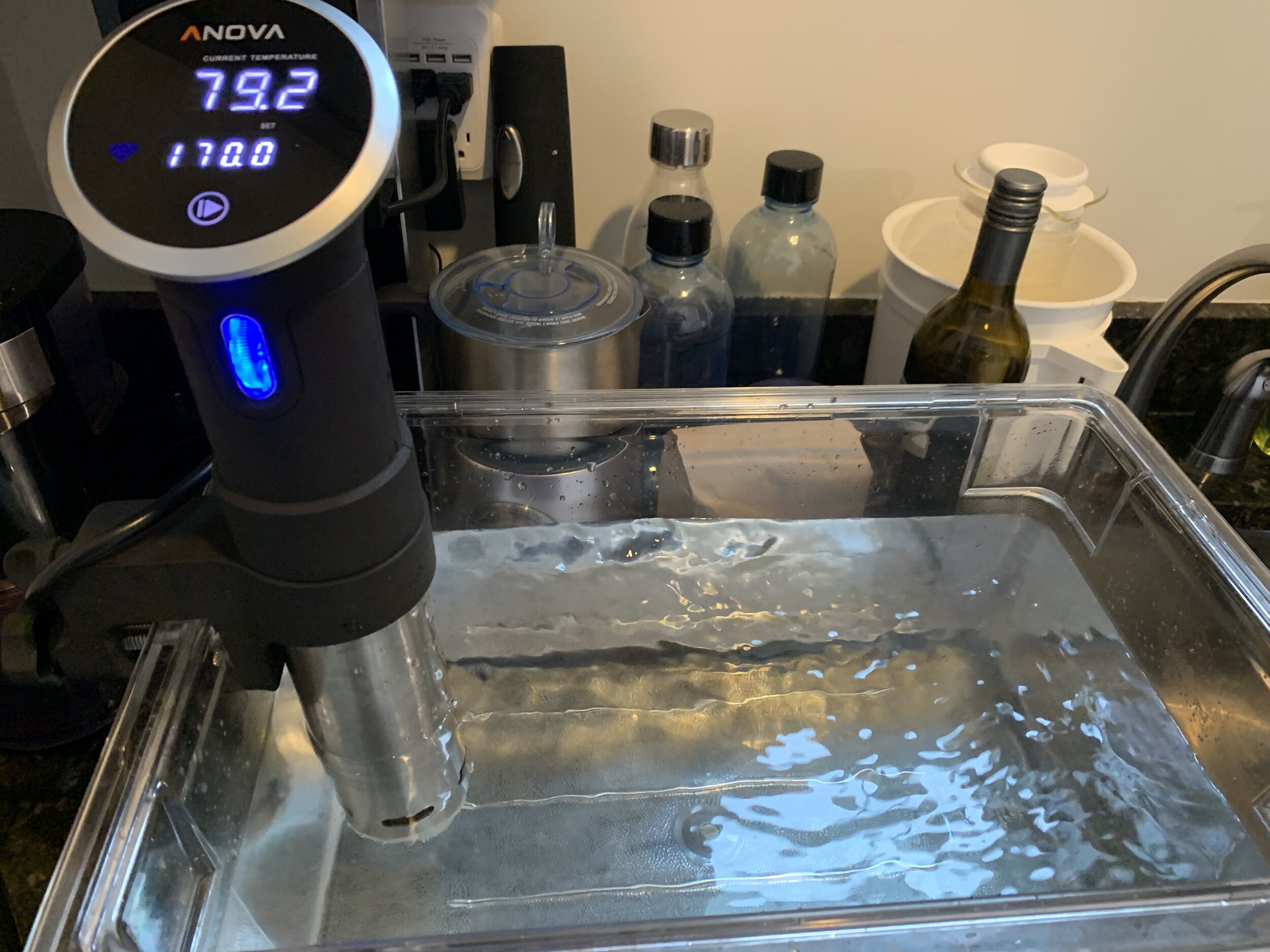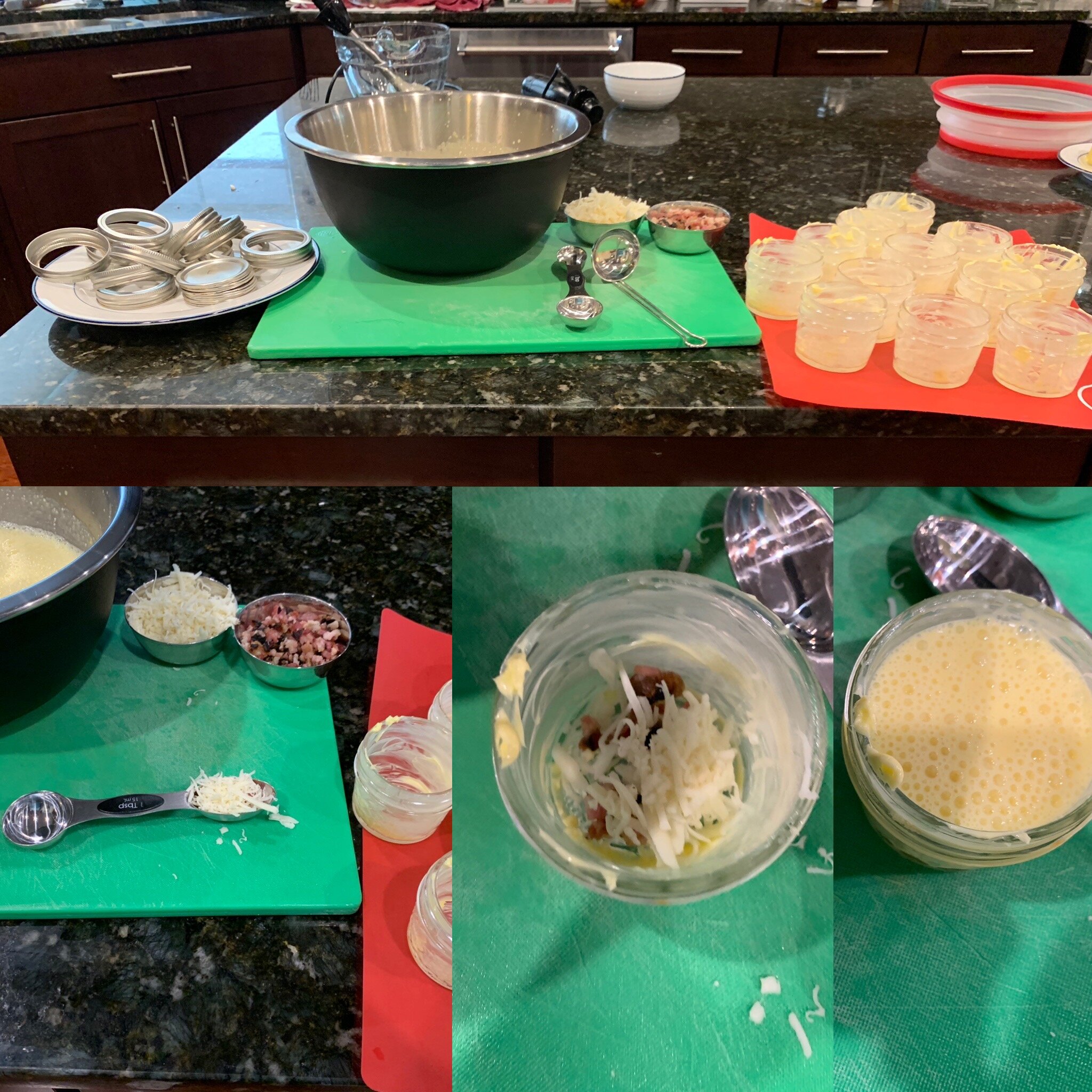Sous Vide Egg Cups
Nuts and Bolts:
I love these egg cups because they are a huge timesaver. This breakfast saves us money by reducing our trips to Starbucks to buy their sous-vide eggs. I can also make several egg cups at once so that my family can stick in the microwave for a quick meal. The only downside is that it takes special equipment to make them. My husband used the allure of making these egg cups for me to agree to purchase a thermal immersion circulator.
My thought on Sous vide egg cups:
Do not be afraid of the equipment used to cook these egg cups. It is easy to use.
This recipe is doubled from the original recipe, so it is easy to scale.
You can fill these cups with any filling of your choice. I am making my family’s favorite, which bacon and Gruyère. Previously, I have made them with sausage and cheddar as well as Gruyere and spinach.
These can stay in the fridge for up to a week, and they can also be heated in a microwave.
Method:
The first thing is to set-up my rig for the sous-vide. The rig includes a Lexan container and a thermal immersion circulator. I fill my container with water until it is between the minimum fill line and the maximum fill line. Then I turn on the sous- vide machine to set it to 170F. My machine will take about an hour to heat up.
Sous-Vide rig: Thermal immersion circulator and Lexan Container filled with water..
As that is heating up, I gather t 12 4 oz mason jars and rings. I re-use lids for sous-viding purposes but not for canning. I put an “E” on these lids to remind me not to use them for canning. I make sure everything is clean before I start. Then I grease the jars with butter. then I line them up.
I chop up my cooked bacon and grate the cheese. I use maybe a strip to strip and half of the bacon and maybe 1/4 of a cup of cheese. I set them in small bowls and put them on a board to create my assembly line.
All the ingredients for the egg mixture.
To make the egg mixture. I add the eggs, cottage cheese, nutritional yeast, and salt into a large bowl. I mix these ingredients using an emulsion blender. I like to use a low setting and gradually bring it up to the highest settings to not get egg mixture all over the place. When it is thoroughly mixed, it will look light yellow and have a very watery consistency.
Then, I create my assembly line to load the jars with the filling and egg mixture. Each jar takes about a tablespoon of the combined filling, so pack a tablespoon measure with each ingredient. It does not need to be exact. Then I put that in the jar and pour the egg mixture over it. I like to leave 1/4 of inch headspace on each jar. Place the lid on the jar and screw on the ring but not too tightly. It needs to t be finger tight. Just continue till you finish filling the jars.
Top of photo:: The assembly line. Bottom Left: A filled tablespoon measure with fillings. Bottom middle, The cheese, and bacon on the bottom of the jar.Bottom-right: Jar filled with egg mixture.
Once the thermal immersion circulator gets the water to 170F, load the jars into the water with a jar lifter or kitchen tongs. I prefer to lay jars flat in the water, but they can be stacked. Then I put plastic balls that float on top of the water. These help keep the water from evaporating and keep the temperature constant. Once the jars are loaded, you will see a drop in temperature. Wait till it comes up to 170F and then set a timer for an hour.
Souv-vide machine with jars.
While I am waiting for this process to finish, I lay out a towel to put the heated jars on. Once the egg cups are done, I lift them out of the water and place them on the towel to cool. They can be eaten right away or stashed in the fridge.
Mess Factor:
Cooked egg on the lids can be hard to clean, and there are times it does clean at all. Just toss those lids out. Also, the jars need to be soaked because the egg or cheese gets melted onto the glass. I soak and rinse my jars before loading in the dishwasher.
Final thought:
We love these egg cups. They always get devoured for breakfast, lunch, and dinner. They have been a live saver when I had a crazy week with no time to cook. I tend to make these on Sunday, so we have them for meals for the workweek.
So Make a Mess with it, Experiment!
A batch of cooling Egg Cups.
Sous Vide Egg Cups:
12 Egg
24 ounces Cottage Cheese
2 tablespoons of Nutritional Yeast
2 teaspoons of salt
Roughly 12 tablespoons of mix-ins
Butter for greasing Jars
12 4 ounces Mason Jars
The set-up of your sous-vide rig. Preheat your thermal immersion circulator to 170F. While the water is heating, prepare your fillings. In a large bowel, mix egg, cottage cheese, nutritional yeast, and salt with an immersion blender until all ingredients become thoroughly blended. Set up your assembly line. To each jar, add a tablespoon of your mix-in, then cover it with egg mixture. Then add lids and rings to close the jars.
Once the sous-vide machine reaches170F put the jars in. The temperature will drop. Add the balls to the machine if using. Then wait till it returns to 170 F and cook for an hour. Take the jars out and place them on a kitchen towel. Eat right away or refrigerate till later.
Based on this Recipe:







